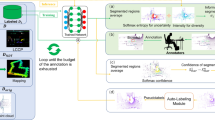Abstract
Domain adaptation for point cloud semantic segmentation is important since manually labeling point cloud datasets for each domain are expensive and time-consuming. In this paper, in order to transfer prior knowledge from the labeled source domain to the unlabeled target domain, we propose a novel domain consistency framework for unsupervised domain adaptive point cloud semantic segmentation. Specifically, in our framework, we construct a multi-level feature consistency model to generate the high quality pseudo labels for the unlabeled target domain. In the constructed feature consistency model, we encourage the labels of feature maps of point clouds at different levels to be as consistent as possible. Based on the generated features with rich geometric structure information, we furthermore impose a feature consistency constraint on the feature memory bank of the source domain and target features to develop a feature bank based cycle association model. Thus, benefiting from the developed cycle association model, we can alleviate the domain gap and learn discriminative features of point clouds for semantic segmentation in the target domain. Extensive evaluations on different outdoor scenarios (“vKITTI to SemanticPOSS” and “SynthCity to SemanticPOSS”) and indoor scenarios (“S3DIS to ScanNet”) show that our framework achieves state-of-the-art performance.
This work was supported by the National Science Fund of China under Grant (No. 61876083), Shanghai Automotive Industry Science and Technology Development Fundation (No. 1917).
Access this chapter
Tax calculation will be finalised at checkout
Purchases are for personal use only
Similar content being viewed by others
References
Achituve, I., Maron, H., Chechik, G.: Self-supervised learning for domain adaptation on point clouds. In: WACV (2021)
Armeni, I., et al.: 3D semantic parsing of large-scale indoor spaces. In: CVPR (2016)
Chen, M., Xue, H., Cai, D.: Domain adaptation for semantic segmentation with maximum squares loss. In: ICCV (2019)
Chen, Y.C., Lin, Y.Y., Yang, M.H., Huang, J.B.: Crdoco: pixel-level domain transfer with cross-domain consistency. In: CVPR (2019)
Cheng, M., Hui, L., Xie, J., Yang, J., Kong, H.: Cascaded non-local neural network for point cloud semantic segmentation. In: IROS (2020)
Dai, A., Chang, A.X., Savva, M., Halber, M., Funkhouser, T., Nießner, M.: Scannet: richly-annotated 3D reconstructions of indoor scenes. In: CVPR (2017)
Gaidon, A., Wang, Q., Cabon, Y., Vig, E.: Virtual worlds as proxy for multi-object tracking analysis. In: CVPR (2016)
Graham, B., Engelcke, M., Van Der Maaten, L.: 3D semantic segmentation with submanifold sparse convolutional networks. In: CVPR (2018)
Griffiths, D., Boehm, J.: Synthcity: a large scale synthetic point cloud. arXiv preprint arXiv:1907.04758 (2019)
Guo, Y., Wang, H., Hu, Q., Liu, H., Liu, L., Bennamoun, M.: Deep learning for 3D point clouds: a survey. TPAMI 43, 4338–4364 (2020)
Jaritz, M., Vu, T.H., Charette, R.D., Wirbel, E., Pérez, P.: xmuda: cross-modal unsupervised domain adaptation for 3D semantic segmentation. In: CVPR (2020)
Jing, L., Tian, Y.: Self-supervised visual feature learning with deep neural networks: a survey. TPAMI 43, 4037–4058 (2020)
Kang, G., Wei, Y., Yang, Y., Zhuang, Y., Hauptmann, A.G.: Pixel-level cycle association: a new perspective for domain adaptive semantic segmentation. arXiv preprint arXiv:2011.00147 (2020)
Langer, F., Milioto, A., Haag, A., Behley, J., Stachniss, C.: Domain transfer for semantic segmentation of lidar data using deep neural networks. In: IROS (2020)
Li, Y., Yuan, L., Vasconcelos, N.: Bidirectional learning for domain adaptation of semantic segmentation. In: CVPR (2019)
Pan, Y., Gao, B., Mei, J., Geng, S., Li, C., Zhao, H.: Semanticposs: a point cloud dataset with large quantity of dynamic instances. In: IV (2020)
Paszke, A., et al.: Automatic differentiation in pytorch (2017)
Qi, C.R., Su, H., Mo, K., Guibas, L.J.: Pointnet: deep learning on point sets for 3D classification and segmentation. In: CVPR (2017)
Saleh, K., et al.: Domain adaptation for vehicle detection from bird’s eye view lidar point cloud data. In: ICCV Workshop (2019)
Tzeng, E., Hoffman, J., Saenko, K., Darrell, T.: Adversarial discriminative domain adaptation. In: CVPR (2017)
Vu, T.H., Jain, H., Bucher, M., Cord, M., Pérez, P.: Advent: adversarial entropy minimization for domain adaptation in semantic segmentation. In: CVPR (2019)
Wang, L., Huang, Y., Hou, Y., Zhang, S., Shan, J.: Graph attention convolution for point cloud semantic segmentation. In: CVPR (2019)
Wang, Z., et al.: Range adaptation for 3D object detection in lidar. In: ICCV Workshop (2019)
Wu, B., Wan, A., Yue, X., Keutzer, K.: Squeezeseg: convolutional neural nets with recurrent crf for real-time road-object segmentation from 3D lidar point cloud. In: ICRA (2018)
Wu, B., Zhou, X., Zhao, S., Yue, X., Keutzer, K.: Squeezesegv 2: improved model structure and unsupervised domain adaptation for road-object segmentation from a lidar point cloud. In: ICRA (2019)
Yang, Y., Soatto, S.: FDA: Fourier domain adaptation for semantic segmentation. In: CVPR (2020)
Yi, L., Gong, B., Funkhouser, T.: Complete & label: a domain adaptation approach to semantic segmentation of lidar point clouds. arXiv preprint arXiv:2007.08488 (2020)
Zhao, H., Jiang, L., Fu, C.W., Jia, J.: Pointweb: enhancing local neighborhood features for point cloud processing. In: CVPR (2019)
Zhu, J.Y., Park, T., Isola, P., Efros, A.A.: Unpaired image-to-image translation using cycle-consistent adversarial networks. In: ICCV (2017)
Author information
Authors and Affiliations
Corresponding author
Editor information
Editors and Affiliations
Rights and permissions
Copyright information
© 2022 Springer Nature Switzerland AG
About this paper
Cite this paper
Bian, Y., Xie, J., Qian, J. (2022). Unsupervised Domain Adaptive Point Cloud Semantic Segmentation. In: Wallraven, C., Liu, Q., Nagahara, H. (eds) Pattern Recognition. ACPR 2021. Lecture Notes in Computer Science, vol 13188. Springer, Cham. https://doi.org/10.1007/978-3-031-02375-0_21
Download citation
DOI: https://doi.org/10.1007/978-3-031-02375-0_21
Published:
Publisher Name: Springer, Cham
Print ISBN: 978-3-031-02374-3
Online ISBN: 978-3-031-02375-0
eBook Packages: Computer ScienceComputer Science (R0)




